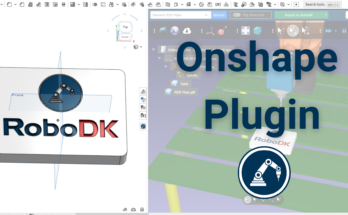Data: some are calling it “the lifeblood of manufacturing’s future,” and with robotics, it’s extra powerful! Here are 11 excellent ways to use your data.
The future of any manufacturing company depends on how well that company handles its data.
In other words, “get good at collecting and analyzing your data, or you might not survive.” That seems to be the prognosis for the manufacturing industry right now.
According to a recent survey from MAPI and Deloitte, 85% of industrial manufacturers believe that smart factory initiatives will be the main driver of manufacturing competitiveness in the next five years. As MAPI explains, the “elemental force” behind smart factories is a company’s operational data and it is the “lifeblood of manufacturing’s smart future.”
Robotics is a key technology when it comes to operating well with data. Of course, data applies to all areas of a manufacturing business. But, most robots are already perfectly suited to a data-driven operation, if use them correctly.
Robots already collect data about their own operation hundreds of times per second. As they are easy to reprogram, they can be used to quickly react to changes in the production flow that you have detected by analyzing data elsewhere in your operation.
Here are 11 excellent ways to combine data and robotics to improve your manufacturing business.
1. Harness Existing Data
Of course, using operational data is certainly not a new thing. Manufacturers have been collecting their operational data for at least the last 20 years. The difference now is that there are more powerful ways to combine and analyze data across your entire business.
In the past, you might have collected basic operational statistics about each machine individually. You may have just collected it manually and analyzed it every so often to track each machine’s productivity in the long term.
Now, you can receive and analyze data in real-time and (if you’re set up for it) adjust production immediately.
Look at the data you already collect in your business. Ask how you could collect it more easily and how you could use it better.

2. Monitor Machines for Maintenance
Using data in maintenance can save you a lot of time and money. Instead of maintaining machines to a fixed schedule — as has been the most common method until now — you can choose to maintain machines only when they actually need it.
Various modern industrial robots include the capability to track their own operation for maintenance. FANUC robots, for example, track metrics like the number of cycles, operating temperature, operator activities, etc.
3. Continually Optimize Your Process
The old adage “what gets measured gets managed” is important for manufacturers. By measuring your process and analyzing the trends, you can continually optimize your production in a way that has never been possible before.
A basic example is improving the cycle time of your robot cell. Even small reductions in cycle time can translate to huge time savings and production increases in the longer term.
4. Improve Resource Allocation
Real-time operational data allows you to tell almost immediately when you need to reallocate resources in your process.
For example, you can see immediately when one robot cell is maxed out but another is running at reduced capacity. This allows you to move the excess work onto the free robot and keep production flowing.
5. Track the Product Journey
Tracking products has become a vital way to use data since the introduction of more automation into factories. When you have fewer human operators — or no humans at all — you need a reliable way to track the product in its journey through your process.
Technologies like RFID are often used with automation, but robots with 2D vision can also read barcodes and QR codes to track products and record their progress to the cloud.

6. Customize Products for Customers
As we explained in a previous article, we are now entering “The Age of Personalization.” Manufacturers who offer customization of their products now have a competitive edge over those who don’t.
Data is important at many stages in the path of customization, from using it to detect customers’ preferences to keeping track of each customized product throughout the manufacturing process.
7. Identify Automation Opportunities
It can sometimes be tough to know which manual task is the best candidate for robotic automation. By analyzing operational data, you can see where the bottlenecks in your process usually turn up and where a robot would make the most impact.
You can then use the same metrics to determine the effect of the robot once it has been running for a while.
8. Improve Quality Assurance
Robotic inspection is a great way to autonomously collect data for quality assurance purposes. It overcomes one of the big challenges of gathering data, i.e. the time it takes when data must be collected manually.
For more on this, read The Manufacturer’s Guide to Robotic Inspection.
9. Reduce Downtime
In general, reducing downtime allows you to increase production. By collecting your data across your manufacturing process, you can tell very easily — in some cases in real-time — which parts of your operation are not running at full capacity.
It’s also possible to reduce downtime on your robot cell by switching to offline programming if you aren’t using it already.
10. Make Better Business Decisions
Ultimately, the biggest benefit of improving how you use data is that it helps you make better business decisions.
For too long, manufacturers have relied mostly on “anecdotal and tribal knowledge” to make decisions about their business.
These days, it is usually a mistake to rely on your “gut instinct” without having some good data to back it up. But to get that data, you probably need to improve the way you gather data in your manufacturing business.

11. Stay Competitive
As Manufacturing Net explains:
“As the most successful manufacturing leaders already know, Big Data analytics are no longer a “nice to have” for manufacturing enterprises. [They] provide the competitive edge companies need to succeed in an increasingly complex environment.”
The biggest benefit of improving your manufacturing with data is that it helps you to stay competitive. Your competitors are probably already finding better ways to use their own data, so you need to keep up.
How could you improve how you use data in your business? Tell us in the comments below or join the discussion on LinkedIn, Twitter, Facebook, Instagram or in the RoboDK Forum.




